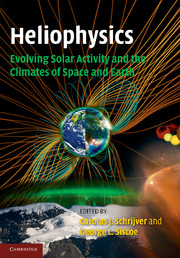Book contents
- Frontmatter
- Contents
- Preface
- 1 Interconnectedness in heliophysics
- 2 Long-term evolution of magnetic activity of Sun-like stars
- 3 Formation and early evolution of stars and protoplanetary disks
- 4 Planetary habitability on astronomical time scales
- 5 Solar internal flows and dynamo action
- 6 Modeling solar and stellar dynamos
- 7 Planetary fields and dynamos
- 8 The structure and evolution of the three-dimensional solar wind
- 9 The heliosphere and cosmic rays
- 10 Solar spectral irradiance: measurements and models
- 11 Astrophysical influences on planetary climate systems
- 12 Assessing the Sun–climate relationship in paleoclimate records
- 13 Terrestrial ionospheres
- 14 Long-term evolution of the geospace climate
- 15 Waves and transport processes in atmospheres and oceans
- 16 Solar variability, climate, and atmospheric photochemistry
- Appendix I Authors and editors
- List of illustrations
- List of tables
- References
- Index
- Plates
4 - Planetary habitability on astronomical time scales
Published online by Cambridge University Press: 05 April 2013
- Frontmatter
- Contents
- Preface
- 1 Interconnectedness in heliophysics
- 2 Long-term evolution of magnetic activity of Sun-like stars
- 3 Formation and early evolution of stars and protoplanetary disks
- 4 Planetary habitability on astronomical time scales
- 5 Solar internal flows and dynamo action
- 6 Modeling solar and stellar dynamos
- 7 Planetary fields and dynamos
- 8 The structure and evolution of the three-dimensional solar wind
- 9 The heliosphere and cosmic rays
- 10 Solar spectral irradiance: measurements and models
- 11 Astrophysical influences on planetary climate systems
- 12 Assessing the Sun–climate relationship in paleoclimate records
- 13 Terrestrial ionospheres
- 14 Long-term evolution of the geospace climate
- 15 Waves and transport processes in atmospheres and oceans
- 16 Solar variability, climate, and atmospheric photochemistry
- Appendix I Authors and editors
- List of illustrations
- List of tables
- References
- Index
- Plates
Summary
Introduction
This chapter discusses general concepts of planetary habitability as well as major events in Earth's history that relate to habitability over its full past and future evolution. The Sun plays a determining factor for habitability in the solar system as other stars also are critical to habitability in other planetary systems. Stars provide well-known benefits to life, but they also cause life-ending processes such as the loss of oceans and the loss of planetary atmospheres.
Environmental limits for life as we know it
Because life has not been detected anywhere but on Earth, the nature of extraterrestrial life remains completely unknown. In light of this famous shortcoming we can still use environmental requirements for terrestrial organisms to estimate where organisms similar to life-as-we-know-it might plausibly exist elsewhere. While this can be criticized as being overly provincial, the Earth-biased approach provides a practical means to access the potential habitability of other worlds. For life based on complex interactions of compounds analogous to the biomolecules of life on Earth, it is relatively straightforward to set general constraints on environments that might support life similar to life-as-we-know-it.
Many of the environmental constraints are influenced by the central star in a planetary system, as the Sun does in our solar system. The Sun provides warmth and energy for photosynthesis, but it also influences many of Earth's fundamental atmospheric, oceanic, and biological processes.
- Type
- Chapter
- Information
- Publisher: Cambridge University PressPrint publication year: 2010
- 2
- Cited by



